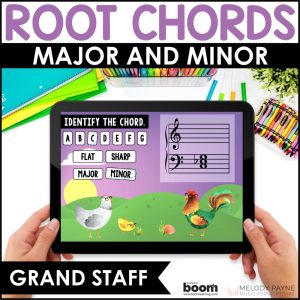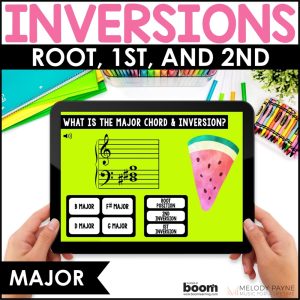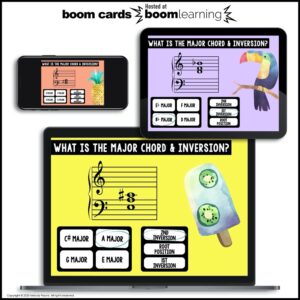
Teaching Major Chords and Inversions with Visual Aids
This post may contain affiliate links. If you purchase something through an affiliate link, I will receive a small commission at no cost to you. For more information, read the disclosure statement here.

Inside: Five quick flash card activities that make chord inversions click for your students in just 3-5 minutes per lesson! This blog post includes research-backed visual learning strategies and step-by-step instructions for games like “Speed Sort Challenge” and “Chord Progression Builder.” You’ll discover how to help students recognize inversions instantly, build sight-reading confidence, and connect written notation to keyboard geography through hands-on activities that work in private lessons, group classes, and online teaching. Your students will finally have those amazing lightbulb moments where chord inversions make perfect sense!
Table of Contents
Picture your piano student’s face lighting up as you’re teaching major chords and inversions, and they finally understand how inversions work.
Instead of feeling confused about which chords they should play when they see different inversions in their music, they immediately recognize them and play them confidently.
These kinds of lightbulb moments come from having the right teaching tools and strategies to help students truly understand concepts like major chords and their inversions.
Teaching Major Chords and Inversions with Visual Aids
Research shows that visual learning approaches are particularly effective for learning information involving pattern recognition and spatial relationships.
According to recent studies, visual learning tools help students organize and process complex information more effectively, making those tools valuable for teaching musical concepts like chords and inversions.
When students can see patterns and relationships on the page, their understanding of musical structures deepens significantly (Alabi, 2024).
This visual approach is especially powerful for teaching chord inversions, where students need to understand both the relationships between notes on the staff and their application on the keyboard.
Why Visual Learning Works for Teaching Major Chords and inversions
I’m a visual learner, so I can really relate to using visual aids to help solidify information I’m trying to learn and retain.
Knowing from personal experience how helpful visual aids can be makes me especially excited to see my students improve by using them too!
When we combine visual learning with hands-on piano teaching, we tap into multiple learning pathways that help students:
- Recognize chords and inversions instantly on the grand staff.
- Understand the relationship between written notation and keyboard geography.
- Develop faster sight-reading abilities for chord passages.
- Make connections between the shapes of chords and inversions in different keys.
- Build confidence in their music theory knowledge and application.
My favorite visual learning aid? Flash cards! I’ve used them all my life, and I was happy to learn more ways that their use is supported by research.
Let’s take a look at 5 flash card activities you can use when teaching major chords and inversions.
5 Activities for Teaching Major Chords and Inversions
Here are five quick and effective activities you can use in your very next lesson when you’re teaching major chords and inversions.
Each activity can be done in both private and group settings and can be adapted for online lessons too!
I recommend printing the flash cards onto white card stock and laminating if you want them to stand up to frequent use and last a long time.
1. Teaching Major Chords and Inversions with “Chord Inversion Inspection”
Objective: Help students recognize chord inversions quickly while building visual and muscle memory
Materials: Major chord flash cards, piano
Time: 3-5 minutes
Instructions:
- Place 4 cards on the piano, showing the same chord in different inversions.
- Have students identify the chord and inversion on each card and put the inversion in order: Root, 1st, 2nd, Root.
- Ask them to play the chords in order, noticing how their hand shape changes for each chord and inversion.
Group Lessons: Have students take turns identifying the chords and inversions, putting them in order, and playing them, or have a different student complete each task.
Online Lessons: Hold 4 cards close to the camera and allow online students to put them in order and play them.

2. Teaching Major Chords and Inversions with “Speed Sort Challenge”
Objective: Develop quick chord recognition and sorting skills
Materials: Major chord flash cards, optional timer
Time: 2-3 minutes
Instructions:
- Use the cards that say Root, 1st, and 2nd for the sorting piles.
- Shuffle the chord cards and place face down in a pile.
- Student flips one card at a time and sorts by chord inversion (Root, 1st inversion, or 2nd inversion).
- Time how quickly the student can accurately sort all cards.
Group Lessons: Create teams and make it a friendly competition to see which team can correctly sort the cards the fastest.
Online Lessons: Teacher flips cards while student names them.

3. Teaching Major Chords and Inversions with “Chord Progression Builder”
Objective: Build and play a chord progression
Materials: Major chord flash cards, piano
Time: 4-5 minutes
Instructions:
- Choose a key and choose the appropriate cards to create a short chord progression (for example, to create I-IV-V in the key of C Major, students will need C Major, F Major, and G Major chord cards).
- Student plays the progression using the root position chords.
- Student can experiment with different inversions to hear how it changes the sound.
Group Lessons: Each student chooses and plays one chord in the progression.
Online Lessons: The teacher shares cards on the screen, and the student uses the cards to create a chord progression.
More Chords Resources You'll Love
-
Major Chords Cheat Sheets and Posters – Print At Home Music Resources for Piano
- $6.00Earn 6.00 Reward Points
- Add to cart
-
Music BOOM™ Cards for Piano – Grand Staff Major and Minor Root Position Chords
- $4.00Earn 4.00 Reward Points
- Rated 5.00 out of 5
- Add to cart
-
Music BOOM™ Cards – Major Chords – Root, 1st, 2nd Inversions on the Grand Staff
- $4.00Earn 4.00 Reward Points
- Rated 5.00 out of 5
- Add to cart
-
Chord Flash Cards – Major, Minor, Diminished, Augmented Root Position Chords
- $6.00Earn 6.00 Reward Points
- Add to cart

4. Teaching Major Chords and Inversions with “Musical Memory Match”
Objective: Matching notated chord inversions with the names of the chords
Materials: Major chord flash cards (print single-sided and create matching pairs of notation and chord names)
Time: 3-4 minutes
Instructions:
- Lay cards face down on a table (notation cards and corresponding chord name cards).
- Student flips two cards at a time to find matches.
- When a match is found, student plays the chord and keeps the cards.
- Continue until all pairs are matched.
Group Lessons: Take turns finding matches. The student with the most pairs at the end wins!
Online Lessons: The teacher arranges cards. The online student indicates which cards the teacher will flip. Or the teacher can show the student two cards and the student can tell the teacher if they are a match.

5. Teaching Major Chords and Inversions with “Inversion Creation Station”
Objective: Build chord inversions
Materials: Major chord flash cards (use the text side of the cards “C Major, 1st Inversion”, etc.), Music note flash cards
Time: 3-4 minutes
Instructions:
- Shuffle the major chord cards and place them on a table.
- Student draws a card and reads the text from the card (for example, “C Major, 1st Inversion”).
- Student uses the music note flash cards to spell the chord.
- Student plays the inversion on the piano.
Group Lessons: 1. Students take turns creating the inversions from the music note flash cards, and everyone plays the chord on the piano. 2. Students work in groups of 3: One reads the text, another builds the inversion, another plays the chord on the piano.
Online Lessons: Teacher draws a card and shows/says the name of the chord (“C Major, 1st Inversion”) to the online student. The online student spells the chord from bottom to top (“E, G, C”) and plays the chord.

Join the #MajorChordChallenge
If you’re ready to create some excitement around teaching major chords and inversions in your piano studio, join the major chord challenge!
How to Participate in the #MajorChordChallenge
- Choose one of the above activities.
- Spend 3-5 minutes on chord work in a lesson this week.
- Take photos or videos of your students in action (with permission).
- Share your success stories using #MajorChordChallenge.
- Tag @melodypaynepiano in your posts to be featured on social media!
When we’re teaching major chords and inversions, it’s important for all of us to remember that consistent, brief practice with these visual tools will help our students develop strong chord recognition skills that will benefit them for a long time.
I’d love to see how you use these activities in your teaching! Join the #MajorChordChallenge and share what you’re doing.
You might just inspire someone else to try something new in their studio too!
More Articles about Teaching Chords and Inversions
- Proven Strategies for Teaching Chords and Inversions
- 9 Multi-Sensory Chord Games and Activities for Piano Lessons
- Teaching Scales, Chords, And Arpeggios Using The Superstar Scales Piano Technique Book
Frequently Asked Questions
Q: How much lesson time should I spend on these chord activities to keep students engaged?
A: I recommend just 3-5 minutes per activity – that’s the sweet spot! These quick bursts keep students excited and focused while building solid chord recognition skills. You can easily rotate between different activities each week so it always feels fresh and fun.
Q: Some of my students really struggle with reading chord inversions. Will these visual activities work for them?
A: Absolutely! Visual learners especially benefit from seeing the patterns, and younger students love the game-like format of these activities. Start with the “Chord Inversion Inspection” activity since it combines visual recognition with the physical experience of playing the different hand shapes – it’s perfect for building that connection between what they see and what they play.
Q: Can I use these activities in group lessons, or are they just for private students?
A: These activities are fantastic for group lessons! I’ve included group adaptations for each one because the competitive element really motivates students. The “Speed Sort Challenge” becomes especially exciting when teams compete, and “Musical Memory Match” turns into a fun group game where everyone cheers each other on.
Q: What if my student gets frustrated when they can’t identify inversions quickly?
A: Start slow and celebrate every small win! I always remind students that recognizing chord inversions is like learning to read – it takes practice, but once it clicks, it opens up so much musical understanding. Focus on one chord family at a time, and use lots of encouragement when they spot even one inversion correctly.
Q: How do I adapt these visual activities for online piano lessons?
A: Online lessons work great with these activities! I hold the flash cards close to my camera so students can see them clearly, and they can still play along on their piano.
Q: How will I see these chord inversion skills show up in my students’ regular piano pieces?
A: You’ll notice the difference quickly! When students can instantly recognize chord inversions in their music, they stop stumbling through chord passages and start playing them confidently. It’s like giving them a musical superpower! Suddenly those intimidating-looking chord progressions become familiar friends they can sight-read easily.
References
Alabi, M. (2024). Visual Learning: The Power of Visual Aids and Multimedia.
Don't miss out!
Follow on Facebook and Instagram, join the best Facebook group for piano teachers, and subscribe to the newsletter to get helpful teaching tips, resources, and tutorials delivered straight to your inbox every week.
Melody Payne
Melody Payne
Welcome!

Hi! I’m Melody Payne, a pianist and piano teacher, educational resource author, a fun-loving wife to the most wonderful and talented hubby I could ask for, and a lifelong learner who loves to share. I want to make your life as a music teacher easier by writing and sharing helpful and relevant music teaching articles, and by creating educational resources with your very own students in mind. If you are a parent who wants to enroll your child in piano lessons, I’d love for us to get started building those skills that can give your child a lifetime of musical enjoyment!












